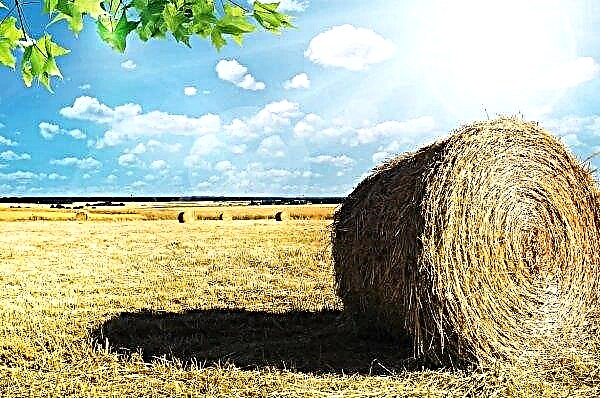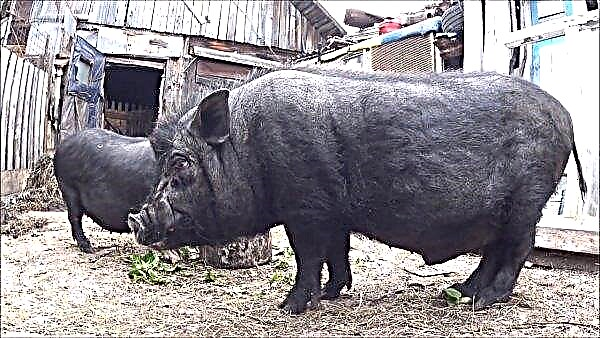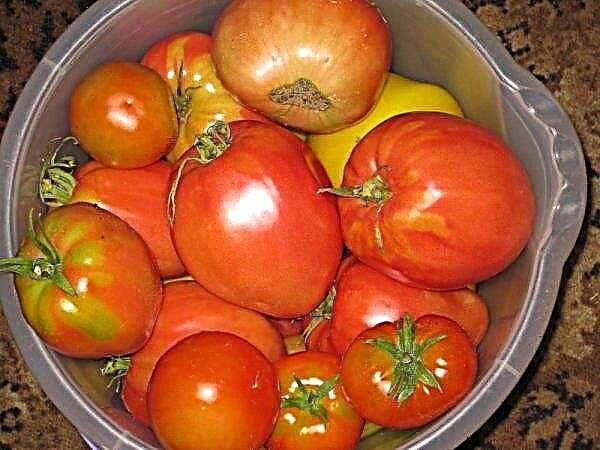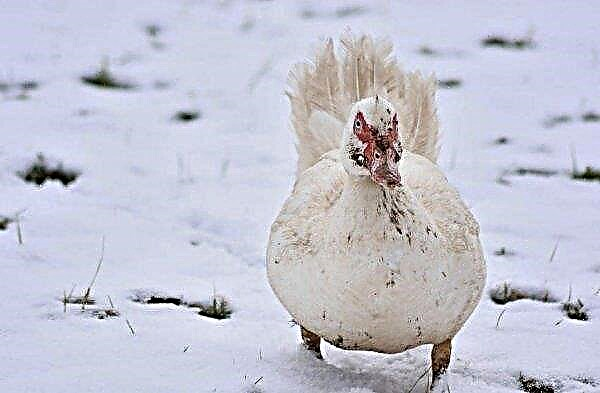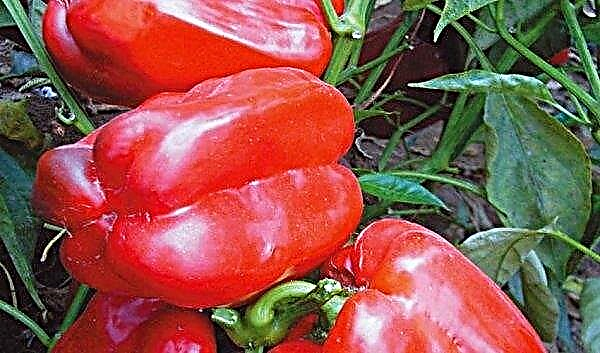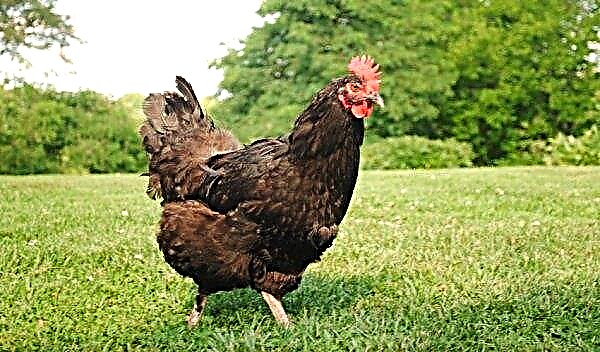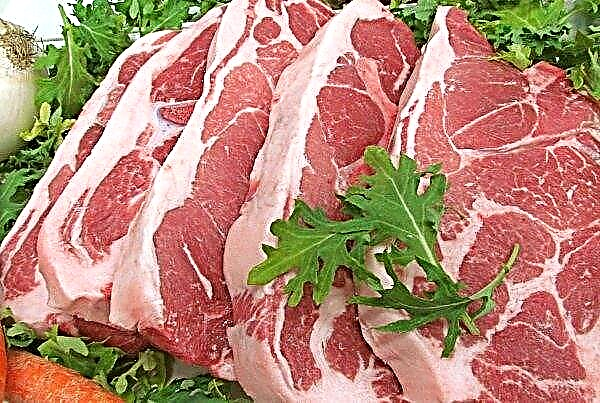Despite the development of genetic methods and the annual appearance of new varieties of white cabbage, there are hybrids that have been deservedly in demand among gardeners for many years and have not lost ground. One of these hybrids is Menza F1, which will be discussed in the article.
Hybrid breeding history
Menza F1 (from the name "mensa" - "table") belongs to the hybrids of the Dutch group and was created back in the middle of the last century, and in 1960 it was recommended for cultivation by the USSR State Commission for Variety Testing. With a complex of valuable attributes, Menza is used by scientists as a promising source material for the selection of hybrids for the Far Eastern region.
Did you know? Cabbage head is actually a huge mutated apical kidney.
Description and characteristic
Mensa is preferred to grow both large industrial enterprises and gardeners. Consider the characteristic features of this common hybrid.
Appearance of cabbage
Menza has large, flat-rounded, dense heads of cabbage (average weight 4–9 kg, but there are cases when they grew to 12 kg). The outer stump is small, which makes it possible to spud the plant only once (instead of the standard two). Heads of cabbage do not crack and “stand on the vine” well, despite their size.

Cabbage leaf:
- medium size;
- wavy along the edge;
- gray-green;
- with a wax coating, providing good keeping quality;
- juicy, sweet, crispy.
Ripening dates and resistance to cold
Menza refers to medium-late varieties. The timing of the final formation and ripening of the vegetable falls in mid-August - September. The growing season lasts about 110 days after planting in the ground. Hybrid tolerates heat and lack of moisture more easily than many other representatives of the Cabbage family. Menza also has good frost resistance and can be grown in various climatic regions (including Siberia and the Urals).
Positive qualities and disadvantages of the variety
- For more than half a century of cultivation history, Menza has gained wide popularity due to the following positive qualities:
- great taste;
- juiciness;
- high sugar content (7%);
- "Smoothness" of heads of cabbage;
- universality in application;
- high productivity;
- resistance to temperature extremes;
- excellent durability and transportability.
Large-fruited Menza is perceived by the mistresses ambiguously. On the one hand, large heads of cabbage give a greater yield of products, on the other hand, it is not as convenient to work with them as with compact ones. The disadvantages of the hybrid can also include low immunity to a fungal disease - keel.
Did you know? Amateur performances for a narrow circle - “cabbage” got its name due to the fact that it was originally arranged during autumn harvesting of cabbage. Young people went from house to house and combined harvesting vegetables with fun and refreshments.
Agriculture cultivating varieties
Mensu is grown by the seedling method, a detailed description of which is given below.
Preparation of seed for seedlings
Planting material is purchased only in specialized stores, as collecting seeds from hybrids does not make sense (they do not retain the characteristics of the variety). The producer usually pellets the seeds (treated with growth stimulants and disinfect with chemicals) therefore there is no need to do it yourself. For the same reason, the seeds are not soaked in water so as not to wash away the protective layer.
Further seedling care
The algorithm for planting and seedling care is as follows.
- To get strong seedlings, you need to pre-prepare (preferably in the fall) a soil mixture consisting of equal parts of leafy soil and humus, as well as vegetable ash (based on 1 tbsp per 1 kg of soil).
- Seedlings are sown in early March, using wooden boxes or plastic containers. Seeds are deepened by 1 cm in a well-moistened soil mixture, at a distance of 5 cm from each other, and put the container with soil in a room with an air temperature of at least 24 ° C.
- Seedlings should be expected in about a week. After that, the room temperature is reduced to 17 ° C, and the seedlings themselves are placed on a well-lit window sill. On cloudy days, you will need additional illumination with a fluorescent lamp. Seedlings are watered as necessary.
- In order to provide young plants with nutrition and to achieve a sufficient volume of roots, 2 weeks after complete germination, the seedlings are carefully dive into separate pots (5 × 5 cm in size). Before picking, the container is treated with a weak solution of potassium permanganate or copper sulfate.
- 10 days before planting in open ground, seedlings begin to be hardened: they take the pots out into the fresh air, covering them with gauze from the sun, and first leaving them for an hour, gradually increasing the time until the whole daylight hours.





Preparation of the place and soil on the bed
For planting, you should choose areas with a medium loamy soil composition and pH 6.5–7.5. The cabbage is photophilous, but still you need to take care of protection from the scorching sun and plant nearby corn or sunflower. Soil preparation begins in the fall when digging and applying organic fertilizers. In the spring, the garden is re-excavated, introducing 200 grams of wood ash per 1 m², 1 tbsp. nitrofoski and 1 part urea.
Important! The key to a good harvest is crop rotation. Good precursors for cabbage are rye, onions, bean early ripe potatoes, cucumbers and carrots.
Seedling planting scheme
Seedlings are considered ready for transplanting into the open ground in the presence of 4-5 true leaves. Usually this happens in the first decade of May, when the soil has already warmed up to at least + 10 ° С. The roots of seedlings are deepened into the soil by 5 cm, while the distance between the seedlings is 50 cm, and the row spacing is 60 cm.
Features cabbage care
Mensa does not require complicated care and is completely dispensed with standard agrotechnical procedures. These include:
- Watering. After transplanting seedlings, cabbage is watered daily. When the bush grows, watering is reduced to two times a week, focusing on the condition of the soil. Daily watering will be required again during setting a head of cabbage (mid-June). Watering rate - 3 liters per bush. For irrigation, only warm water is used. Watering is done in the morning or evening. 3 weeks before harvesting, watering is stopped to prevent cracking of heads of cabbage.
- Top dressing. Two fertilizers per season will suffice. 2 weeks after transplanting, seedlings are added with organic fertilizers in combination with nitrogen fertilizers (for example, mullein solution and 10-15 g of urea per 10 l of water). During the formation of fruits, phosphate-potassium complexes are used (40 mg of superphosphate and 20 mg of potassium nitrate, diluted in 10 l of water).
- Loosening and weeding. Usually combined with watering. The depth of cultivation is about 25 cm. In total, from 3 to 6 cultivations are carried out per season, including one hilling - during the formation of heads of cabbage. To form an earthen cushion from the upper layer of soil, a special hiller or hoe is used.
- Disease and Pest Prevention. As already mentioned, Menza has a good resistance to many fungal diseases, with the exception of the keel, which affects the roots. This disease can be prevented by treating the soil before planting with a solution of potassium permanganate (2 mg per 10 l) or colloidal sulfur (5 g per 1 m²).




Features of harvesting and storage of crops
Ripe cabbage is cut off with a sharp knife, leaving 3-5 cm of fruit stalk. After cutting the heads, the legs are dug up along with the roots. For saving, intact, firm heads are selected. Before laying for storage, special attention is paid to inspecting vegetables for moisture on the surface of cabbage rolls (the slightest drops can lead to fungus).
Storage periods vary depending on the location of the swingers:Important! The optimum storage temperature for fresh cabbage is 0 ° C, and humidity is at least 80%.
- Stored in a cellar (in boxes, in parchment paper or in sand), cabbage preserves its taste and presentation for the longest time (up to six months).
- You can also store heads on the top shelf of the refrigerator, pre-wrapping them with cling film. In this case, cabbage will delight you with excellent taste for about a month.
- If there is no cellar or enough space in the refrigerator, you can save the cabbage in the pantry or on the insulated balcony. Subject to the microclimate, Menza will remain fresh, at least until the New Year holidays.
The currently popular freezing method is also suitable for cabbage. You can freeze whole heads of cabbage and chopped leaves. The freezing temperature is –18 ° С. The disadvantage of this method is the loss of "crispness" and, to some extent, presentation after defrosting. However, the taste remains unchanged. Menza leaves - not only an ingredient for salads and stuffed cabbage. This hybrid is great for pickles and pickles. Salting is the preservation of cabbage using table salt. Canned cabbage can be stored until summer even at room temperature. Unlike salting, the classic recipe for sauerkraut consists in fermentation under oppression for 2–7 days, followed by storage at a temperature not exceeding 0 ° С.
Menza leaves - not only an ingredient for salads and stuffed cabbage. This hybrid is great for pickles and pickles. Salting is the preservation of cabbage using table salt. Canned cabbage can be stored until summer even at room temperature. Unlike salting, the classic recipe for sauerkraut consists in fermentation under oppression for 2–7 days, followed by storage at a temperature not exceeding 0 ° С.


